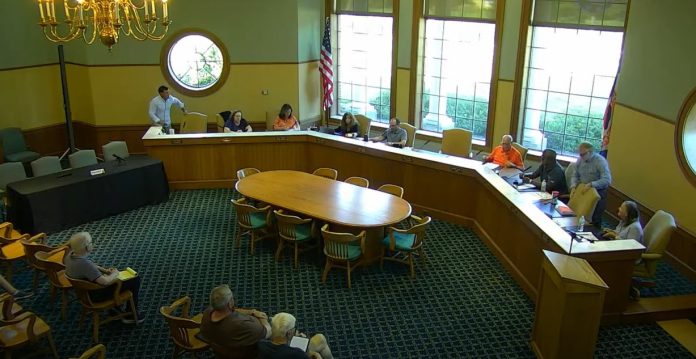Orange Village Council conducted interviews with four architecture firms on August 18 during a special meeting as the village moves forward with plans for a new fire station and village hall renovations. The projects are being fast-tracked to meet a May 2026 ballot deadline for voter approval.
The interviews, held at village hall, featured 30-minute sessions with each firm as council members evaluated their qualifications and approach to the dual projects. Mayor Jud Klein outlined the village’s vision during opening remarks, explaining the need for modern facilities to serve the community for the next 30 years.
Project Background
The current village hall was built 30 years ago when Orange Village was served by a volunteer fire department. Klein said the building now lacks adequate facilities for male and female firefighters and police officers, proper decontamination areas, sufficient locker space, and modern training facilities.
After initially considering expansion and renovation of the existing building in 2022, village leadership determined that approach would create only a “band-aid solution.” The new plan calls for constructing a new fire station at Harvard and Brainard roads on a 2-acre parcel purchased from the Western Reserve Land Conservancy, then renovating village hall to move police operations into the current fire department space.
The Competing Firms
Bialosky Partners led off the interviews with principal Jack Bialosky, managing principal Paul Deutsch, and project manager John Guzac. The firm emphasized their AIA Gold Medal status and previous work with Orange Village, including the service facility and involvement in the village’s master planning process. Deutsch, an Orange High School graduate, highlighted his local connections and experience with similar projects in Pepper Pike and Moreland Hills.
Richard L. Bowen and Associates presented next with president Alan Renzy, project manager Robin Wolf, and architect Julia Weiss. The 66-year-old Cleveland firm emphasized their civic and public safety expertise, with Wolf serving as director of civic justice projects. The team stressed their experience with police and fire facilities and their systematic approach to stakeholder engagement.
DS Architecture brought owner Jeff Meyers alongside partners from K2M Design including retired California fire chief Von Miller and mechanical engineer Mark Witz. Meyers highlighted his 27 years in civic architecture and the team’s national experience with 12 active public safety projects. They provided a detailed timeline showing how to meet the May ballot deadline.
Perspectus Architecture concluded the interviews with principal Peter Bohan, senior project director Dave Verbansky, and Joe Weitman from partner firm Mullen Weissman Architects. The team emphasized their combination of local municipal experience and national fire station expertise, currently working together on Rocky River’s fire station project.
Key Council Concerns
Council members focused heavily on budget accuracy and cost control. Each firm was asked about their approach to reliable cost estimating and their track record of staying within budgets. Most firms emphasized using professional third-party estimators and maintaining contingencies for market volatility.
Several firms acknowledged current construction costs running $550-600 per square foot for fire stations, highlighting the importance of realistic budget planning from the project’s start.
Council also explored how firms would handle stakeholder engagement, with all teams emphasizing the importance of involving police and fire personnel as well as community members in the design process.
Technology and Sustainability
When asked about green technology integration, firms showed varying levels of experience with solar and geothermal systems. Some noted that while sustainable technologies are beneficial for long-term municipal ownership, upfront costs often challenge municipal budgets.
Several firms mentioned federal tax incentives available for energy-efficient municipal buildings, though client demand for these features has decreased in recent years.
Single Firm vs. Split Approach
A key decision point emerged around whether to hire one firm for both projects or split the work between two firms. While all firms expressed capability to handle both projects, opinions varied on the optimal approach.
Mayor Klein, drawing on his architecture background, suggested potential benefits to using two firms for fresh perspectives on each distinct project type. However, several council members expressed preference for continuity with a single firm, particularly given the projects’ budget interdependence.
Public Input Concerns
Council received written comments from resident Stacy requesting delays in the decision-making process to allow more public deliberation. The commenter expressed concern about the rushed timeline between meetings and called for more community input opportunities.
Council President Vincent Silver clarified that no decisions would be made during the special meeting, with formal deliberations scheduled for the September 3 council meeting.
Next Steps
Council will spend the next two weeks reviewing the presentations and gathering additional input before making their selection at the September 3 meeting. Some members suggested narrowing the field to two finalists to streamline discussions.
Once an architect is selected, the village will begin developing preliminary designs and cost estimates needed for the ballot initiative. The projects represent one of the largest infrastructure investments in Orange Village’s recent history.
The village has already budgeted funds for the initial design and feasibility work, with major project funding dependent on voter approval in May 2026.
Article from earlier this month – Orange Council Meeting
Discover more from Northeast Ohio News
Subscribe to get the latest posts sent to your email.











